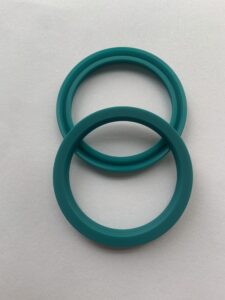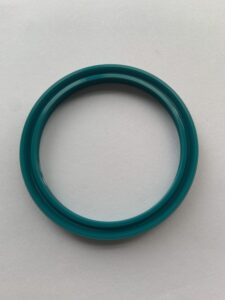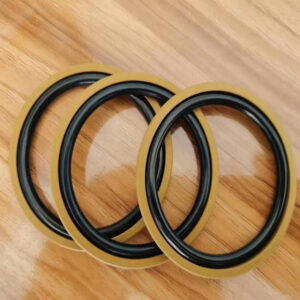Table of Contents
ToggleWhat is Rod or Piston Seal?
Rod and piston seals are two indispensable components in hydraulic and pneumatic systems, each serving distinct roles to ensure efficient operation and longevity of cylinders, pumps, and actuators. This article explores their definitions, functions, materials, applications, and maintenance practices, highlighting their differences and complementary roles.



Overview: Roles in Fluid Power Systems
In hydraulic and pneumatic cylinders, rod seals and piston seals work together to manage fluid or gas pressure, prevent leaks, and protect internal components. While both are dynamic seals, their locations, designs, and operational focuses differ significantly:
- Rod Seals: Located at the cylinder gland (where the piston rod exits), they prevent external leakage and contamination.
- Piston Seals: Mounted on the piston head inside the cylinder bore, they separate pressure zones to enable force transmission.
Defining Rod Seals
What is a Rod Seal?
A rod seal (also called a gland seal or neck seal) is a dynamic sealing element installed around the reciprocating piston rod at the cylinder’s exit point. Its critical functions include:
- Leakage Prevention:
- Forms a pressure-tight barrier to retain hydraulic fluid or compressed air inside the cylinder.
- Prevents fluid from escaping along the rod’s surface during reciprocating motion FPE Seals.
- Contamination Exclusion:
- Works alongside wiper seals to block dust, dirt, and moisture from entering the system, safeguarding internal components DMS Seals.
- Lubrication Retention:
- Maintains a thin oil film on the rod surface to minimize friction and wear.
Design and Materials
- Profiles:
- Single/Double-Lip Seals: For basic to high-pressure applications.
- Buffer Seals: Absorb pressure spikes to protect primary seals.
- Spring-Loaded Seals: Ensure consistent contact under variable motion Espint.
- Materials:
- Polyurethane (PU): High abrasion resistance for heavy-duty use.
- Nitrile Rubber (NBR): Cost-effective for low-pressure systems.
- PTFE: Low friction and chemical resistance in harsh environments Parker.
Defining Piston Seals
What is a Piston Seal?
A piston seal (or head seal) is a static or dynamic seal fitted into a groove on the piston head. Its primary roles are:
- Pressure Separation:
- Blocks fluid from bypassing the piston, maintaining differential pressure for efficient force output Wikipedia.
- Wear Reduction:
- Often paired with wear rings or guide rings to prevent metal-to-metal contact between the piston and cylinder bore Espint.
- Bidirectional Sealing:
- Available in single-acting (unidirectional) or double-acting (bidirectional) designs, sometimes energized by O-rings for stability Yokey Seals.
Design and Materials
- Profiles:
- U-Cups: For bidirectional pressure handling.
- Chevron (Vee) Seals: Stackable for heavy loads.
- Composite Seals: PTFE shells with elastomer energizers for low friction.
- Materials:
- PTFE: Ideal for high-temperature or chemically aggressive fluids.
- Fluorocarbon (FKM): Resists heat and oxidation.
- Polyurethane: Balances durability and flexibility.
Rod Seal vs. Piston Seal: Key Differences
| Aspect | Rod Seal | Piston Seal |
|---|---|---|
| Location | Cylinder gland (rod exit) | Piston head (inside bore) |
| Primary Role | Prevent external leakage & contamination | Separate pressure zones across piston |
| Sealing Direction | Radial (against rod surface) | Axial (between piston and bore) |
| Pressure Focus | External leakage prevention | Internal pressure differentials |
| Failure Modes | Wear from friction, extrusion | Extrusion, chemical degradation |
Shared Characteristics
- Materials: Both use elastomers (NBR, FKM) or thermoplastics (PTFE).
- Critical Requirements:
- Surface smoothness (rod: 0.2–0.4 μm Ra; bore: <0.8 μm Ra).
- Compatibility with operating fluids, temperatures, and pressures.
- Installation: Precision fitting and lubrication are vital for both.
Applications Across Industries
1. Construction & Mining
- Rod Seals: Excavators and cranes rely on robust seals to exclude abrasive contaminants.
- Piston Seals: Heavy-duty presses require seals that withstand high axial pressures Barnwell.
2. Manufacturing & Automation
- Rod Seals: Robotics use low-friction PTFE seals for precise motion.
- Piston Seals: Injection molding machines depend on pressure-separating seals for cycle efficiency Valin.
3. Automotive Systems
- Rod Seals: Suspension systems use elastomeric seals for shock absorption.
- Piston Seals: Engines and transmissions rely on heat-resistant FKM seals.
Maintenance & Best Practices
For Rod Seals
- Inspect Regularly: Check for rod surface scratches, wear grooves, or leaks.
- Pair with Wiper Seals: Use mild wipers to avoid stripping the rod’s lubrication film.
- Replace Proactively: Address wear during system overhauls to prevent downtime.
For Piston Seals
- Monitor Alignment: Ensure piston and bore are concentric to avoid uneven wear.
- Check for Extrusion: Replace seals showing flattening or deformation.
- Lubricate Properly: Use fluids compatible with seal materials to prevent swelling.
Universal Tips
- Cleanliness: Debris-free installation prevents premature failure DMS Seals.
- Documentation: Follow manufacturer guidelines for lip orientation and backup rings.
Material Selection Guide
| Material | Rod Seal Use Cases | Piston Seal Use Cases |
|---|---|---|
| Polyurethane | High-abrasion environments (mining) | Moderate-pressure industrial systems |
| NBR | Cost-sensitive, low-pressure systems | Automotive hydraulics (non-extreme temps) |
| PTFE | Chemical/food processing | High-temperature engines and pumps |
| FKM | Aggressive fluids (fuel, acids) | Aerospace and high-heat applications |
Conclusion
Rod seals and piston seals are complementary yet distinct components critical to fluid power systems. While rod seals focus on external integrity—preventing leaks and contamination—piston seals ensure internal efficiency by managing pressure differentials. Their material and design choices must align with operational demands, from extreme pressures in construction machinery to precise motion in robotics. By understanding their roles, differences, and maintenance needs, engineers can optimize system performance and longevity.



Leave A Comment